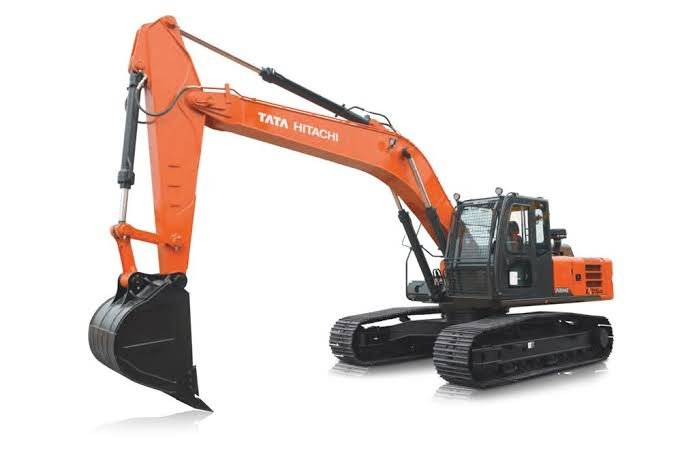Tata Hitachi EX 215 (LC/LCQ/Prime) Excavator: A Review

In the Indian construction equipment market, where infrastructure, mining, and quarry operations demand rugged and reliable machines, the Tata Hitachi EX 215 series – including models such as the EX 215 LC, EX 215 LCQ, and EX 215 LC Prime – has carved out a niche. This review provides a closer examination of the key attributes, strengths, and areas for caution for this excavator family, primarily targeting M–L sized operations approximately 20-ton class) in India.
1. Key Specifications & Features
- The EX 215 LCQ (Super+ Series) is built for quarry and heavy-duty use: it offers an engine with ~133 PS (≈98 kW) at 2,000 rpm.
- Operating weight is in the region of ~21,000-22,000 kg (≈21 t) depending on variant.
- Bucket capacity is around 0.9–1.0 m³ in standard quarry spec.
- Engine & hydraulic system: For example, the Prime variant offers ~140 HP (≈104 kW) and a digging depth of ~5,910 mm.
- Key features include:
- A robust undercarriage and frame structure for heavy-duty/quarry use (e.g., heavy-duty boom, arm, track link/chain, sprocket) in the LCQ variant.
- Advanced hydraulics: Tata Hitachi uses its Optimum Hydraulic System (OHS) for smooth combined operations (travel + boom/arm, swing + front-end) and quick coupler/attachment adaptability.
- Fuel saving/efficiency modes: e.g., “EP (economy) mode” vs “HP (high power) mode”.
- Operator comfort and serviceability: Spacious cabin, easy service access, telematics/diagnostic support.
2. What Works Well — Strengths
- High durability for tough sites
The LCQ variant is explicitly engineered for quarry applications with heavy wear conditions: 25 % thicker shoes, heavy-duty track links and chain, reinforced frames, etc. This means better resilience when used on harsh terrain or rock extraction environments. - Versatility & attachments
The machine is built to work with a range of attachments: rock breaker piping kits, quick coupler twin-lock, grabs, clamshell buckets, etc. For contracting businesses that switch jobs/sites, this offers good flexibility. - Fuel efficiency/cost control
The presence of EP mode, auto-idle/auto-deceleration features, and regeneration hydraulics helps reduce fuel consumption when full power isn’t needed. Given fuel is a major cost on large-hour machines, this is a meaningful advantage. - Strong brand & support
Tata Hitachi has a wide service network in India, and the backing of the Tata group + Hitachi’s global hydraulic expertise provides confidence. For buyers, access to spare parts and service is a key factor in uptime and total cost of ownership. - Good resale/ROI potential
With robust build, established brand, and versatile use, the EX 215 family tends to hold value reasonably well in the Indian market (though exact resale depends on hours/condition). The manufacturer emphasises “higher resale value” in product literature.
3. Considerations & Potential Drawbacks
- Weight and transportability
At ~21 t operating weight, transport and logistics (movement between sites, road permits, extra haulage cost) become significant. For lighter job sites, this may be over-capacity. - Versus global peers – operating cost/parts cost
While the machine is designed for Indian conditions, heavy-duty use still means higher parts consumption (undercarriage wear, pins/bushes), and the cost of heavy-duty tracks/shoes is non-trivial. Also, operators report in similar machines (not necessarily this model) that parts cost/maintenance access can become challenging. - Versatility trade-off
The LCQ variant is tailored for quarry work; if your usage is more general construction (urban, trenching, utility work) then a standard 20-ton class excavator might suffice and be more cost-efficient. Choose a variant that matches the job profile. - Operator training and maintenance discipline are required
To get the fuel efficiency and smooth hydraulics benefits, operators must be trained to use modes (economy vs HP) and proper maintenance must be followed (filters, hydraulic system, etc). If neglected, the advantage diminishes. - Market competition & availability of alternatives
The 20-ton excavator market is competitive in India; buyers should compare the total cost of ownership, dealer support, and parts availability across brands before making a final decision.
4. My Verdict – Good Fit For & When To Think Twice
Good fit for:
- Quarry, heavy excavation, mining, or large‐scale infrastructure sites where ruggedness and durability matter.
- Contractors need flexibility with attachments and quick coupling for multiple job types.
- Buyers who plan high utilisation (many hours/year) and therefore benefit from better fuel efficiency, durability, and resale value.
- Operations in India that value strong local support and parts network.
When to think twice / consider alternatives:
- If the work is light (urban trenching, utilities, small buildings), a lighter machine may suffice with lower ownership cost.
- If your job site has poor access or you frequently move the machine on roads or through tight city spaces (weight, size, transport cost matter).
- If your local support/dealer for Tata Hitachi in your region is weak or parts lead-time is high (check this beforehand).
- If the initial cost is very high compare,d to the budget and utilisation is expected to be low, then ROI could be slower.
5. Final Takeaway
The Tata Hitachi EX 215 series (especially LC/LCQ/Prime) offers a well-balanced package of rugged performance, versatility and cost-control features for heavy-duty excavation in India. If you match the machine to your job-profile (i.e., heavy work, high hours, need for attachments and durability), then it is a strong contender. As with any heavy machinery investment, it pays to do a thorough cost-of-ownership evaluation: purchase cost, fuel consumption, maintenance, transport, operator capability, resale.
